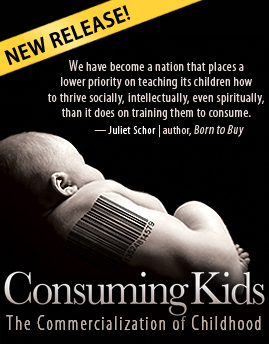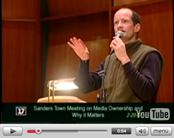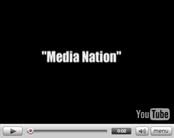FILM REVIEW: Branded New World - “Consuming Kids” Goes Inside The Twisted World of 21st Century Children’s Marketing

In honor of Waitsfield Elementary School’s Scholastic-Free book fair going on over this next week, in which parents and teachers bypass the corporate commercial marketers to deliver books of their own selection to our school for affordable purchase by students and families, let’s cut to the chase.
The 21st century United States is now home to 52 million kids under the age of twelve.
Folks who work with these kids - parents, teachers and health care professionals - are deeply concerned about ever-increasing rates of bipolar disorder, depression, type II diabetes, hypertension, and obesity. All recent trends brought on, in part, by our kids’ unhealthy “media diet.”
But for Big Media advertisers, these kids represent the most profitable demographic in marketing history, as they spend or influence the spending of (can you say “nag factor?”) 40 billion dollars a year.
The bottom line - marketers targeting kids now spend an annual $17 billion to try and reach our little ones.
What the heck is going on?
This is the question explored in an important new film by the Media Education Foundation called “Consuming Kids.” The film is a provocative look inside the deeply twisted world of corporate commercial children’s marketing, and features a wide-ranging cast of parents, scholars, educators, authors, and citizen activists, all of whom have spent years defending kids from the voyeuristic predations of corporate marketers.
“Voyeuristic predations?” Certainly, you exaggerate.
Nope. In the film, Boston College Born to Buy author/scholar Juliet Schor (a parent of two) details how marketers routinely conduct focus groups with little kids splashing around in showers and bathtubs. Why? To make close and careful observations about how kids interact with products as banal as bath soap, so these marketers can better enhance the marketing power of their emerging wares.
Now that’s creepy. Yet it happens routinely in the world of children’s marketing.
Consider the following few examples:
• “American Idol,” with its seamless merging of product placement (Coke, anyone?) and entertainment, is one of the country’s most watched show for kids between the ages of 2 and 11.
•
• Marketers routinely conduct MRIs on children – tracking their neurophysiological responses to various ad messages to better refine and sharpen the persuasive power of these messages.
• Contrary to what you might think, “Seventeen” magazine – with its relentless “hair, clothes, make-up = life” message, is not read by teenagers. Instead, the magazine (and dozens just like it) is read by “tweens” – girls between the ages of 8-12.
• In 2006, fast food restaurants in the United States sold more than 1.2 billion children’s meals with toys to children under 12.
• What about Baby Einstein? The film suggests that this $20 million for-profit “educational” enterprise is nothing more than a scam – as there is absolutely no research proving the effectiveness of the device.
When did this relentless marketing assault begin? The film rightly notes that, while advertising to kids has been with us for decades, the commercial “carpet bombing” of our young people began in earnest in the late 1970s and early 1980s, sanctioned by a Congress that “defanged” the Federal Trade Commission (the FTC is the federal agency charged with regulating advertising to kids) and the deregulatory environment ushered in by the Reagan administration.
The numbers tell part of the story. During the early 1980s, marketers spent $100 million a year to reach kids. Today, the numbers are astronomical, contributing to a kids culture that emphasizes, according to one observer, “self indulgence, instant gratification, obsessive materialism, and a “this is about me in these things now” attitude.
Our brave new world of immersive media technologies – the Internet, mobile phones (5 million American kids between 5 and 12 years of age have ‘em), text messaging, mp3 players and the like – offer unprecedented opportunities for marketers to access the hearts, minds and wallets of kids like never before. Anyone who has ever seen a Webkinz at work knows how marketers use a $15 stuffed animal to drive kids online (visit the web site and enter your secret code, so you can meet ad shop with other owners!) where corporate marketers can gather personal information to continue their marketing game.
The bottom line? “We have become a nation that places a lower priority on teaching our children how to thrive socially, intellectually, even spiritually,” Juliet Schor concludes, than it does on training them how to consume.”
Indeed.
What can we do about all of this? Cradle-to-grave media education in our classrooms and communities is a good place to start, and is making inroads in schools and communities around the country. Organizing community campaigns to regulate marketing in our schools and other public spaces is another useful strategy. And educating parents is vital, as well. Ultimately, as parents, teachers, and citizens, it is our collective job to take a stand against the corporate predations of media marketers – for the health of our children, our families, our communities, and our culture.



![View your cart items []](/sites/default/modules/ecommerce/cart/images/cart_empty.png)




